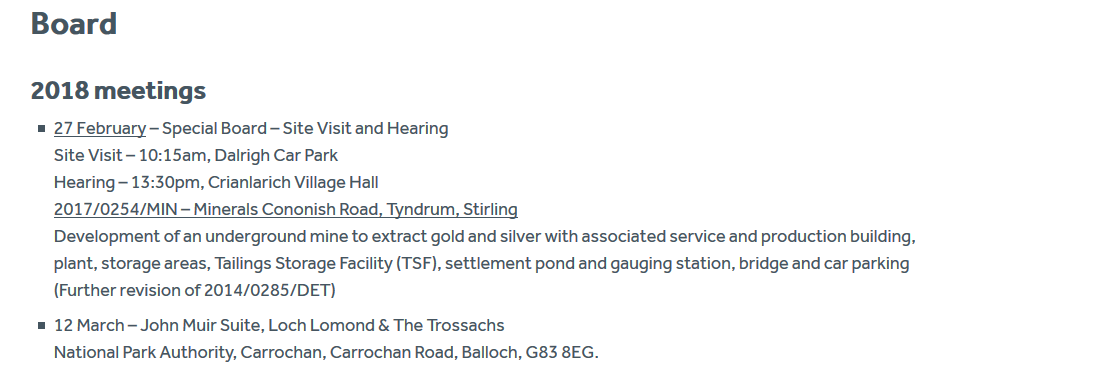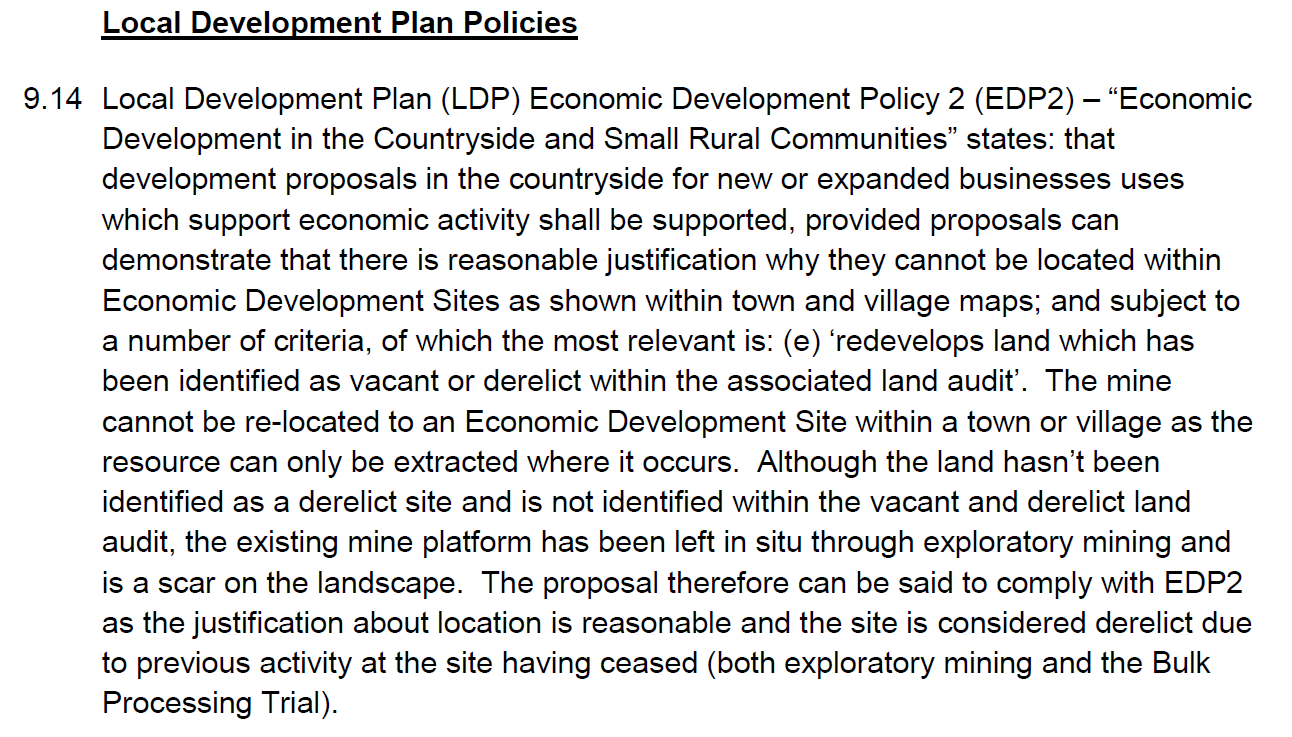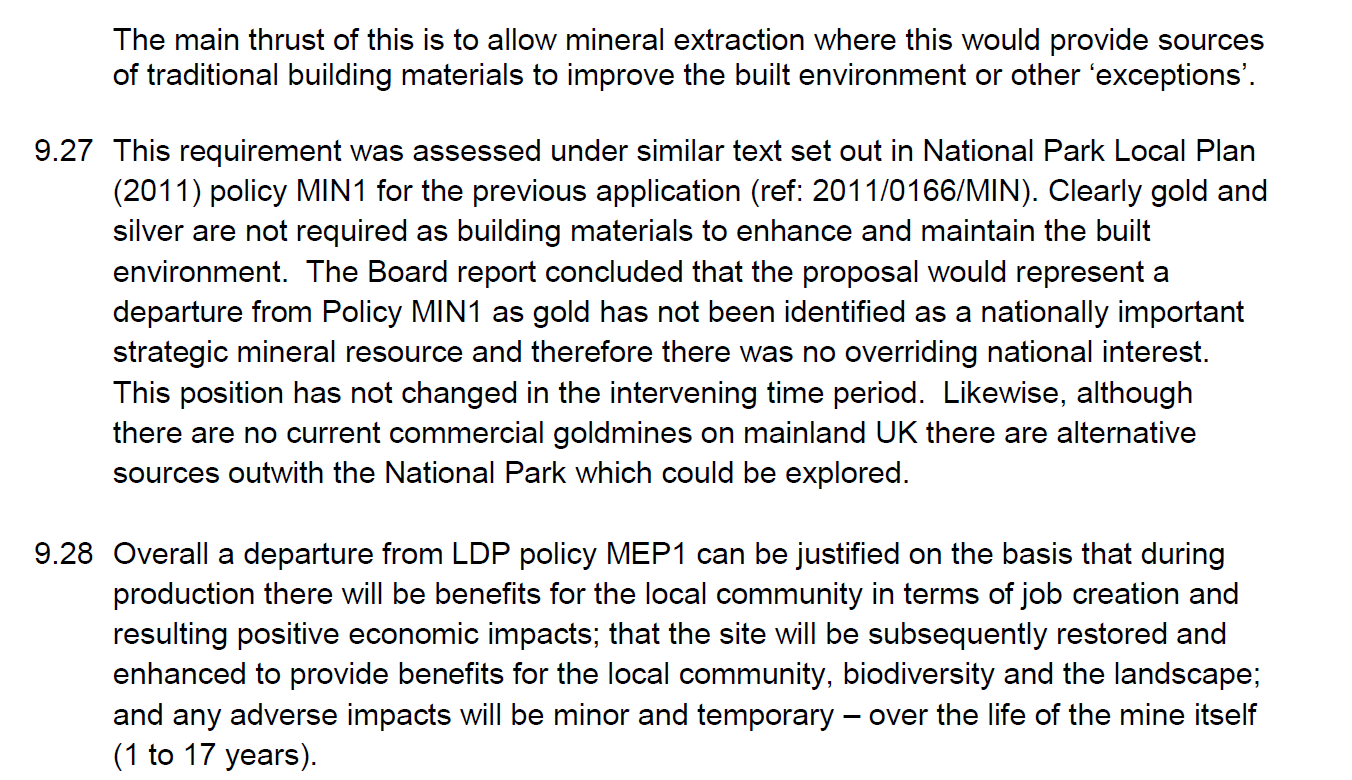
Until a couple of days ago, there was NO information on the Loch Lomond and Trossachs National Park Authority website about Board or Committee Meetings this year, no dates, nothing. I had written to the LLTNPA about this a couple of weeks ago, only to be reminded that the October 2017 Board Meeting had agreed dates for all Board and Committee meetings in 2018 but because it was possible some of the dates might change as a result of a current review of governance, nothing had been published on the LLTNPA website. This is unacceptable.
Back in October a Planning and Access Committee meeting had been scheduled for 30th January but there was nothing on the LLTNPA website to say it had been cancelled. And then, out of the blue, on the 15th the meeting date for a Special Board Meeting on Cononish appeared (together with the date of the March Board meeting) while the Committee papers were made public on the planning portal.

Such lack of transparency is practically unknown in other public authorities, a couple of clicks on google and you can find meeting dates for any Council, as the elected Councillors on the Board should well know (see here for Stirling). The first challenge of the governance review ordered by Board Convener James Stuart should be how to change the senior staff management team so they start acting like public servants rather than unaccountable bureaucrats.
What’s going on with the Cononish Planning application is more serious however. Its not clear who released the story the Herald – unusually no-one is quoted – but it appears to have been timed to coincide with the papers appearing on the Park website. If it was the LLTNPA, it suggest they have already in effect taken the decision but if it was Scotgold, the timing suggests they were tipped off by Park staff when to contact the media. After the Owen McKee scandal, in which the LLTNPA tried to cover up that Owen McKee the Convener of the Planning Committee had been trading in Scotgold shares (see here for example), one might have thought that Park staff would have done everything to ensure the LLTNPA was seen to be squeaky clean.
Either this media announcement was done with Board approval – in which case we are back to the bad old days of Linda McKay’s convenorship where the LLTNPA in effect took decisions at secret pre-meetings held before public Board Meetings – or staff appear to be trying to pre-empt any proper scrutiny or debate about their recommendations. I suspect the latter and, if so, the Board needs to hold staff to account and remind them its Board Members, not staff, who takes the decisions in such cases.
The assessment of the new Cononish Gold Mine Planning Application
In 2011 the LLTNPA reversed its opposition to a gold mine at Cononish and a planning application was subsequently approved in 2012. Nothing significant then happened until 2014-15 when the LLTNPA agreed to a Section 42 variation and extended that permission for a further three years. That permission ran out on 6th February 2018, ie just over a week ago, and means that the current application is the only one on the table. Scotgold had previously advised its shareholders that if the new application, which is primarily driven by a need to reduce costs to enable the development to go ahead, was refused it could revert to the existing one. That is no longer the case.
This is important because through much of the 72 page Committee Report and in many of the 210 accompanying documents (see here) the argument is that the new application is better than the old one and hence should be approved. To me it rather begs the question of how a National Park Authority could have ever approved the old scheme if the impact on the landscape was worse and the risk of collapse of the tailings management dam was higher as is stated in the report? This application needs to decided on its merits.
While the final part of the Committee Report does provide an assessment of the scheme against the LLTNPA’s Development Plan, the National Park Partnership Plan and the statutory objectives of our National Parks, in my view this is far from objective. Here is how the first Local Development Plan policy is evaluated:

So the mine is acceptable because Cononish could be said be a derelict site! I thought it had been designated as a Wild Land Area!! Leaving aside the fact that the current operation and area of “dereliction” only covers a tiny proportion of the proposed site, the developer was required to take out bonds to guarantee restoration of the existing site once operations finished. If the current planning permission was refused, the site would be restored and would not be derelict at all! So, the conclusion that the proposal “can be said to comply with EDP2” is wrong.
Or how about the evaluation in the Committee Report of the mine against the Local Development Plan’s Mineral Extraction Policy 1 which states:
‘New mineral extraction sites shall only [my highlight] be supported where the material to be extracted is required to facilitate the enhancement and maintenance of the National Park’s built environment or, where it can be demonstrated that there is an overriding national interest and there is no reasonable alternative source outwith the National Park.’

The assessment is 9.27 is quite correct and should mean the development should be refused. Instead, para 9.27, gives a number of dubious reasons why Park staff believe the mine should go ahead, none of which override a policy which basically says there should be no gold or other mines in the National Park except for reasons of national interest.
After these examples (and there are many more), you will not be surprised to read that despite also finding that:
“During the construction, operational and decommissioning phases of the mine, years 1-17, this development will be contrary to the Local Development Plan as it will not safeguard, protect or enhance the Landscape, Visual Amenity, Wild Land, Special Qualities, Recreation and Access”
the final recommendation is that the application should be approved, albeit with no less than 57 conditions. Senior Park staff have therefore failed to ensure that the Cononish gold mine application has been evaluated objectively against the LLTNPA’s own policies. I don’t know why this is the case but the failures in logic are so glaring that it appears something else is going on.
What needs to happen
I hope that Board Members read the Committee Report and accompanying papers properly and are not put off by the huge volume of information. If they do so, they should appreciate that reasoning of officers is seriously flawed in a number of places and their recommendations open to legal challenge on a number of grounds. Reasons enough to reject the application.
I will consider the new Cononish proposal’s compatibility with the conservation objectives of the National Park in my next post.
A good objective review of the LLTNPA’s documents. Using my experiences of its sister organisation – CNPA – the Planning Committee members rarely, if ever, go against the Planning Officers’ recommendations. In fact, the whole behaviours of the CNPA Planning Committee is to even avoid a vote at Committee and try to pass the Planing Officers’ recommendations unanimously.
It would be worthwhile comparing the statistics on these two National Park Planing Committees to find out in what percentage of applications the Committee goes against the Planing Officers’ recommendations and what percentage of applications even go to a split vote.
My comments are not trying to measure the quality of the Planing Officers’ work in getting the application to Committee, but I believe such statistics are a measure of how critically Committee Members read the supporting documents and how independent they are of the Planning Officers.